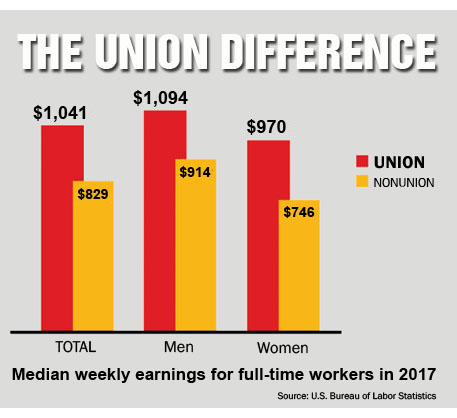LOCAL
Washington state posts big gains in union membership
With 45,000 more members, Washington rises to 3rd most unionized in U.S.
(Jan. 22, 2018) — An estimated 584,000 Washington state residents belonged to labor unions in 2017, a new report from the U.S. Bureau of Labor Statistics shows, an increase of 45,000 from the previous year and 84,000 since 2015. National union membership levels, which have dropped in recent years as Republican lawmakers passed more union-busting “right-to-work” laws, held steady at 10.7 percent in 2017. But unions gained members in many free-bargaining states like Washington, where the union membership level increased from to 17.4 percent in 2016 to 18.8 percent last year.
 “Union growth in Washington state is good for everyone,” said Jeff Johnson, President of the Washington State Labor Council, AFL-CIO. “Union members earn more, spend more in their communities, and lift working standards for all of us. Polls and surveys show that people want to join unions. These numbers demonstrate that, unless they are hindered by outdated or hostile labor laws, people will stand together and form unions.”
“Union growth in Washington state is good for everyone,” said Jeff Johnson, President of the Washington State Labor Council, AFL-CIO. “Union members earn more, spend more in their communities, and lift working standards for all of us. Polls and surveys show that people want to join unions. These numbers demonstrate that, unless they are hindered by outdated or hostile labor laws, people will stand together and form unions.”
Union members earn higher wages, with median weekly earnings of $1,041 compared to $829 for nonunion, according to the new BLS report. With union wages averaging 25 percent higher than nonunion wages, full-time union members make more than $54,000 per year on average, which is $11,000 more than nonunion workers.
LEARN MORE ABOUT FORMING A UNION — If you don’t have a union at your job, learn more about how to organize one. Today’s economy is so out of balance — with all the economic gains going to the top — forming a union is how workers can stand together and demand better wages, working conditions, and a voice on the job. You can make it happen at your workplace! Click here to get started.
 With its 18.8 percent union membership rate, Washington rises to the 3rd most unionized state in the nation, after being 5th highest last year. Only New York (23.8) and Hawaii (21.3) have a higher percentage of their workforce unionized. Although unions grew by 262,000 members nationally in 2017, the national membership rate remains just 10.7 percent, driven down by so-called “right-to-work” states like South Carolina (2.6), North Carolina (3.4), Arkansas (4.0), and Louisiana (4.4).
With its 18.8 percent union membership rate, Washington rises to the 3rd most unionized state in the nation, after being 5th highest last year. Only New York (23.8) and Hawaii (21.3) have a higher percentage of their workforce unionized. Although unions grew by 262,000 members nationally in 2017, the national membership rate remains just 10.7 percent, driven down by so-called “right-to-work” states like South Carolina (2.6), North Carolina (3.4), Arkansas (4.0), and Louisiana (4.4).
Right-to-work laws take away workers’ freedom to join together and negotiate a fair return on their work. These laws ban unions and employers from agreeing to union-security clauses that require everyone covered by the contract to pay a fair-share representation fee. These laws, which have racist origins, require unions to represent everyone, regardless of whether they pay any dues or representation fees. (It’s like allowing people to opt out of paying taxes but still getting to benefit from government services.) Right-to-work laws weaken unions financially, make it much harder to organize workplaces and negotiate contracts, and result in those states having lower wages.
In addition to earning higher wages, another federal report recently showed that union members are far more likely to have employer-provided retirement and health care benefits than their nonunion counterparts.
The Bureau of Labor Statistics found:
— 95 percent of union workers had the option of an employer-sponsored health care plan, compared to 69 percent of nonunion workers;
— 94 percent of union workers had the option of an employer-sponsored retirement plan, compared to 65 percent of nonunion workers; and
— 93 percent of union workers had the option of an employee-sponsored prescription drug insurance, compared to 67 percent of nonunion workers.
In addition, the quality of the benefits provided to union workers typically was better, the data showed. For example, workers were expected to contribute 19 percent toward the cost of the family’s health care under union-negotiated benefits plans, while nonunion workers were forced to shell out 35 percent of the cost, which represents an 84 percent increase in out-of-pocket costs.





